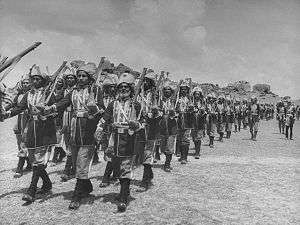Hyderabad State Forces
The Hyderabad State Forces was the armed forces of the kingdom of Hyderabad Deccan. People from various groups were enlisted in the Nizam's army. Among these groups were Arab nationals like Chaush and African nationals like Siddi's who now stay in Barkas and A.C. Guards areas of present Hyderabad respectively [1] who migrated to the Deccan. The Nizam also had about 1200 Sikh guards.[2] Later, Muslims from Audh, Sindh, Balochistan, and surrounding areas in North India also added to bolster ranks. These non-indigenous soldiers were called as "Rohollas". Other battalions within the army were called line "Walas". Some troops were also supplied by Europeans for the security of Nizam.[3]
| Hyderabad State Forces | |
|---|---|
| Sarf-e-khas | |
 Well-armed Lashkars of the Hyderabad army | |
| Founded | 1724 |
| Current form | Some assimilation into the Indian army |
| Disbanded | 1948 |
| Headquarters | Barkas, Hyderabad |
| Leadership | |
| Major general | Syed Ahmed El Edroos (1948) |
Commanding Divisions
Three different groups were commanded by three different independent commanders. The Nizam, Diwan, and an important officer in Nizam's government called Shangal Umara or "Amin Kabir" maintained their own separate forces.[3]
During the time of Operation Polo, the Hyderabad State Forces consisted of six infantry battalions, two Cavalry regiment, 1,500 armed irregulars. The army had two light armored regiments and one field battery.[4] In total, the Nizam's army numbered 24,000 men, of whom some 6,000 were fully trained and equipped. Some of the units surrendered on the first two days of the Operation. Four Hyderabadi infantry Companies and three Cavalry squadrons were later absorbed into the Maratha Light Infantry, Madras Regiment, Poona Horse and Deccan Horse of the Indian Army respectively.[5]
History
British Rule
In 1767-1768, Nizam ʿĀlī accepted British control in Hyderabad by the Treaty of Masulipatam. From 1778 onwards, a British resident and subsidiary force were installed in his dominions. In 1795, Nizam ʿĀlī Khan lost some of his own territories to the Marathas. When he turned to the French, the British increased their subsidiary force stationed in his domain. The Nizam's territorial gains against Tippu Sultan were given to the British.[6]
Surrounded by territory controlled by the British, Nizam ʿĀlī Khan was pushed to enter into an agreement that placed his country under British protection in 1798; the Nizam was the first of many Indian princes to perform this agreement. He was, however, independent in domestic matters.
Nizam ʿĀlī Khan and his soldiers were allied to the British in the Second (1803–05) and Third (1817–19) Maratha Wars, and Nizam Nāṣir al-Dawlah and Hyderabad's military contingent remained loyal to the British during the Sepoy Mutiny (1857–58).
Operation Polo
In September 1948, the Indian Army attacked Hyderabad State due to attacks from the Razakars in surrounding areas. The battle between the Nizam's army and the Indian army had lasted for five days, and had led to an Indian victory. Hyderabad was integrated into the Indian union as a result.[7]
References
- Yimene, Ababu Minda (2004). An African Indian Community in Hyderabad: Siddi Identity, Its Maintenance and Change. ISBN 9783865372062.
- "Maharaja Ranjit Singh's". Archived from the original on 17 April 2015. Retrieved 25 February 2019.
- Rao, P. Raghunatha. ఆధునిక ఆంధ్ర దేశ చరిత్ర (The History of Modern Andhra Pradesh).
- Khanna, K K (7 March 2015). Art of generalship. p. 161. ISBN 9382652922.
- Lucien D. Benichou (1 January 2000). From Autocracy to Integration: Political Developments in Hyderabad State, 1938–1948. Orient Blackswan. ISBN 978-81-250-1847-6.
- "Hyderabad". Britannica. Encyclopædia Britannica. Retrieved 7 October 2016.
- Ramachandran, D.P. Empire's First Soldiers. Lancer. pp. 178–179.